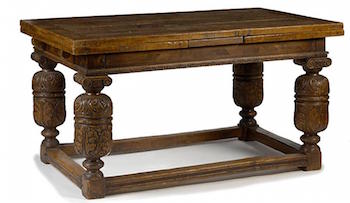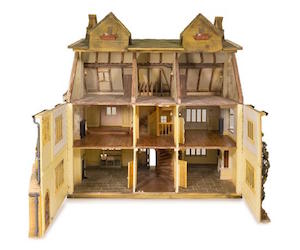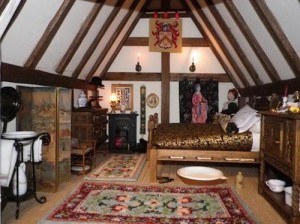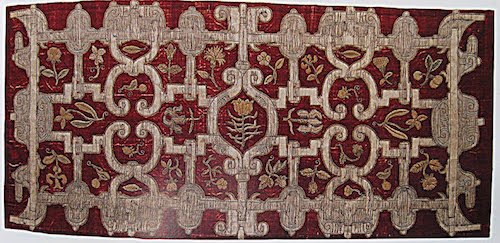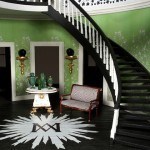Elizabethan Era
Towards the end of Henry VIII’s reign very little building occurred in England. The debts run up by the spendthrift Henry meant that the country verged on bankruptcy. The wool trade, which had carried the economic life of the country in the late medieval period, was no longer as prosperous as it had been. There was less disposable wealth for architectural projects. Under Elizabeth, the fifth and last Tudor monarch, the county’s economy began to revive. The new queen encouraged a return to farming, and the resulting recovery put a reasonable amount of wealth into the hands of a large number of people. This created the Elizabethan passion for tearing down old houses and building anew. Dubbed the “Great Rebuilding, ” homeowners of all classes yearned for improvements.
Definition of Elizabethan Style
1 : an early Renaissance architectural style combining Tudor and Italian features, and characterized by large windows, long galleries, tall decorated chimneys, and a profusion of ornamental strapwork
2 : the Renaissance style of furniture characterized by massive structure and elaborate carving
Stone Is Fashionable Again
Early in the Tudor era, stone was the most commonly used material where it was available. When Henry VIII had over 900 church building dismantled, that left stone plentiful and inexpensive. Then brick became, a new expensive building material, became all the rage. During Elizabeth’s reign stone made a comeback. This had an unexpected change in chimneys. The beautifully decorated brick chimney stacks that adorned the roofs of large buildings became square and were not usually ornamented.
Elizabethan manor
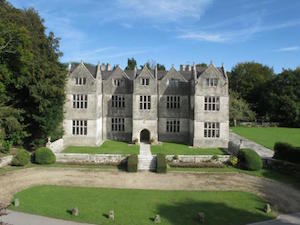
Stone E plan Elizabethan house for sale in Dorset
This new wealth expressed itself in two simultaneous building booms: a significant number of small houses were built; at the same time many country mansions were constructed. Many of the earlier medieval or Tudor manors were remodeled and modernized.
The style adopted by the country house builders was a curious blend of Italian Renaissance tempered with large doses of Dutch influence. Many builders relied on books illustrating Dutch building plans and architectural details. This influence is most readily seen in the curved gables so often used in the Elizabethan period.
Elizabethan E-plan
The courtyard design so prevalent during the medieval and Tudor period gave way to an open E shape, with the vertical line of the E being the main hall, and the shorter horizontal end lines the kitchens and living rooms. The shorter central line was the entry porch. There is likely little truth in the old maxim that the E-plan was a tribute to Elizabeth; it was a natural evolution of the earlier courtyard designs.
On the upper floor of the main hall, a new architectural feature made its appearance; the long gallery. Used for entertaining, as a family area, for exercise on dull days, and as a portrait gallery, the long gallery was an almost universal feature of Elizabethan manors. It featured windows on three sides and fireplaces along the fourth, and it usually ran the entire length of the floor.
Town Houses
Tall, narrow townhouses made the most of the limited space within the borough walls. Merchants and artisans built multi-story homes, often living over the shop. One advantage was that upper stories could be jettied out over the street.
Smaller Elizabethan Homes
The smaller Elizabethan houses were less influenced by Renaissance motifs. They continued to evolve slowly from the Tudor style; fireplaces and chimneys were more common, and staircases featured more prominently. Half-timbering was common. The timbers were spaced more widely apart than in Tudor years, allowing more elaborate infill decoration.
The overall plan of the small Elizabethan house was simple; a central hall, now floored in halfway to the roof, creating an upper story. On either side of the hall were the living area and the kitchen.
The Lower End of the Scale
Chimneys and glazed windows appeared for the first time. Previously people cooked and ate in the hall with a fire on the open hearth. Once a chimney was added, the Hall, formerly open to the rafters, could have a ceiling inserted to make an upper floor. Houses were becoming lighter and cleaner, with more private space.
Typical Half-Timbered Elizabethan House
Windows were generally large, made up of a multitude of small rectangular panes separated by thin mullions. For the first time in centuries, windows show no arching but use a simple dripstone or classical hood molding.
Strap Work
The most common decorative motif of this period is strapwork, used both internally and externally. Carved in low relief, or molded in plaster, the strapwork creates symmetrical geometric patterns that are the unmistakable trademark of the Elizabethan era.
Other popular decorative touches include molded plaster paneling, colored marble (often seen in a black-and-white chequerboard pattern on floors), curvilinear columns, and plaster ceilings molded in imitation of Gothic fan vaulting.
Susan Downing, with Patrick Owens
_________________________________________________________________________
I invite you to visit my Etsy Shop where I offer many accessories and pieces of furniture in 1:12 scale.



